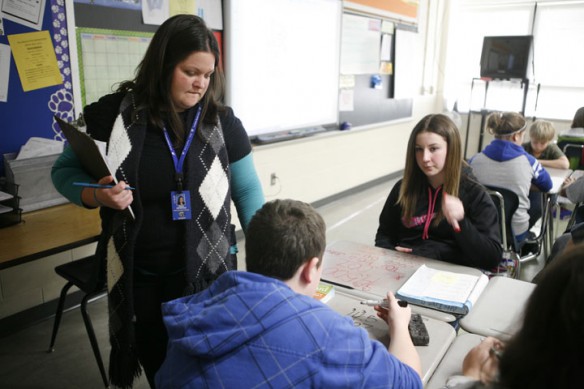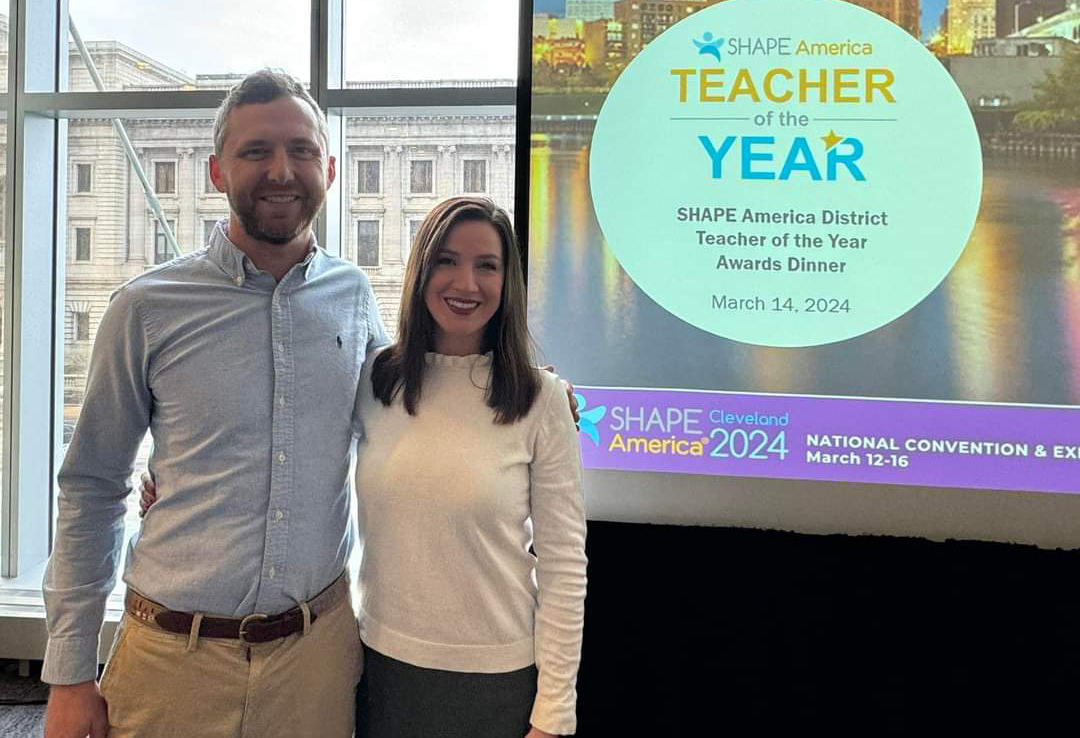
Gina Benham helps 7th-grade student John Monson with a decimal problem during her mathematics class at Woodland Elementary School (Kenton County).
By Susan Riddell
susan.riddell@education.ky.gov
Woodland Middle School (Kenton County) teacher Gina Benham has taught mathematics for four years, but when it comes to stocks and investing she is just like any one of her 7th graders.
“I love an opportunity to learn alongside my students,” said Benham, whose class began involvement with a program in October that ties investing to a real-world mathematic curriculum. “Value is added to this experience when the kids realize they are learning something some adults know little about.”
All 7th-grade classrooms at Woodland Middle and Turkey Foot Middle School (Kenton County) have been participating in the “Investing in Students, Making Math Count” initiative. Following the October kickoff, the students played the Portfolios Investment Simulation Game with volunteers from Fidelity Investments to get a feel for the game.
The volunteers meet with students at both schools on a monthly basis, using investment and finance as a context to address concepts in the 7th-grade mathematics curriculum, according to Jennifer Barrett, Kenton County school district middle and high school mathematics consultant.
“The program created through this partnership is unique because it was designed to be embedded into the mathematics curriculum rather than as an add-on,” Barrett said. “While focusing on the Kentucky Core Academic Standards addressed during 7th grade, the program has the additional benefit of teaching financial literacy. During the design, partners worked together to ensure that all pieces would mesh together, from emphasizing academic vocabulary to focusing on concepts that will help students better meet college readiness.”
Nick Croslin, middle school teacher at Turkey Foot Middle, said the program was designed with the Standards of Mathematical Practice in mind.
“Students are being asked to reason abstractly and quantitatively; to model with mathematics and to attend to precision as they learn about financial literacy in a hands-on, engaging way,” Croslin said. “The online challenge serves to reinforce the ideas in the classroom sessions by tying mathematical concepts to the content being addressed in the common core. Understanding multiple representations, using academic vocabulary and developing conceptual understanding of the connection between math and financial literacy all are goals of the project.”
The online challenge consists of weekly lessons tied to finance and investment. The lessons last for 10-15 minutes. Correct responses earn students virtual money, which they can then invest.
Each week simulates a year of the stock market “so that students get a true sense of the power of compounding,” Barrett said.
Benham said her students have enjoyed learning some of the histories of companies they already are familiar with like Coca-Cola and Nike, and that the mathematics lessons enhance student understanding of rational numbers, number operations and percent.
Students are given the chance to assess themselves in the project, “which is valuable,” Benham said. “The activities we have implemented so far are set up for competition against classmates.
“Students answer questions that go along with the activity, and correct answers are given so students are awarded points if they are correct. Students can make mistakes, but are given the opportunity to learn from them, which can be very powerful.”
Croslin said the online portion of the program clearly shows if students reach mastery of content.
“The developers will be looking at MAP scores of students involved to determine if more growth occurred in those students as opposed to students not involved,” Croslin said. “Additionally, we hope to look at EXPLORE, PLAN and ACT results of these students in the future. Many of the concepts addressed in the project are concepts that will impact the college- and career-readiness skills of students so we hope to see an increase in the number of students reaching the college- and career-readiness standard on the EXPLORE, PLAN and ACT.”
In March, the 128 participating students who earn the most money in the online challenge will get to play the Portfolios Investment Simulation Game against their peers for prizes.
“This project shows students the relevance of mathematics by incorporating technology-based learning in which students connect real-world, relevant mathematical curriculum by learning about investing,” Croslin said.
“The program is continually assessed, monitored and measured and generates hard data about performance success for individual students,” he added. “Teachers are able to differentiate the instruction among students who are at grade level, or performing above or below grade level based on the data.”
“This has been a great opportunity to connect with my students by creating friendly competition against other math classes and learning about investments alongside them,” Benham added. “Any time math can be tied to money, middle school students seem to take more interest.”
MORE INFO …
Jennifer Barrett, jennifer.barrett@kenton.kyschools.us, (859) 957-2680, ext.180
Gina Benham, gina.benham@kenton.kyschools.us, (859) 356-7300
Nick Croslin, nick.croslin@kenton.kyschools.us, (859) 341-0216



Leave A Comment